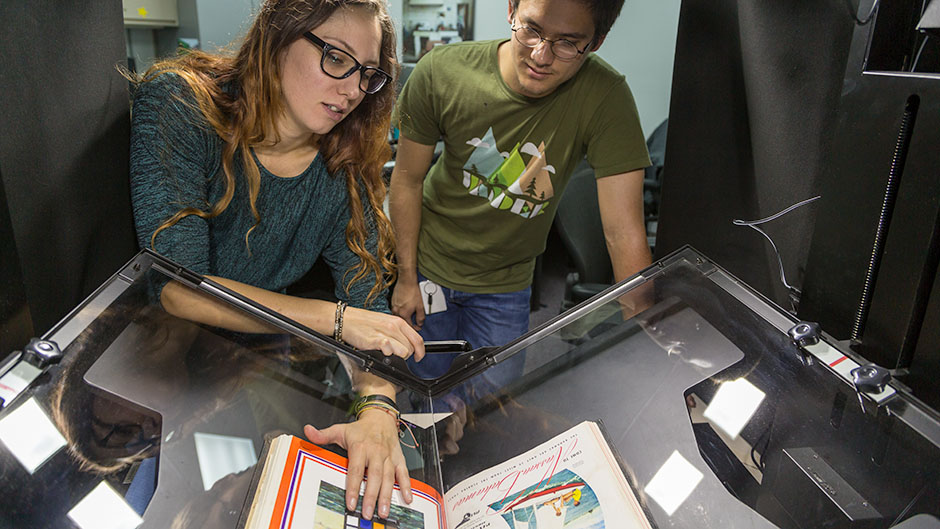A few steps beyond the main elevator on the third floor of the Otto G. Richter Library is a generic looking door numbered 346. Despite its ordinary exterior, this door leads to an extraordinary workspace known as the Digital Production Lab (DPL), where skilled imaging specialists convert a wide variety of traditional library materials into digital formats, including printed books, journals, photographs, maps, manuscripts, fine art, and more.
The faculty, staff, and student assistants of the DPL represent an evolving circulation system that has become a prevailing focal point in the University of Miami Libraries’ (UML) mission to open worlds. In this case, rather than simply delivering printed, physical materials to library patrons in-person, the Lab instead offers local and distant users free access to digital surrogates that span the Libraries’ vast collections and strengthen the foundations of teaching, learning, and research at the University. Perhaps most importantly, the DPL’s expert team ensures the long-term preservation of UML’s unique digital content for future generations of scholars.
For the past 1.5 years, the Lab has fittingly served as the heart of operations for the digitization of materials from the Pan American World Airways, Inc. Records under a grant from the National Historic Publications and Records Commission. Whether scanned in-house or off-site, the DPL acted as both the starting point and finish line for 60 boxes of brochures, timetables, directories, and periodicals from the Printed Materials series of the Pan Am collection—an archive that documents the history of the largest international air carrier in the United States for more than six decades. The combined efforts have since added over 100,000 new images to UML’s Digital Collections, where they are full-text searchable and available for browsing and research.
Interim Associate Dean for Digital Strategies & Head of Digital Production Laura Capell worked with Digitization Project Manager Gabriella Williams to manage the complex workflows involved with preparing the Pan Am boxes for either of two scanning destinations: in-house with the DPL team, or off-site at Creekside Digital, a leading digitization vendor based in Glen Arm, Maryland.
“For a project of this scale, one of the first considerations was the groundwork laid by our staff and students to carefully record each box item-by-item, while maintaining the original order of the folders and verifying the information listed for each document was complete and accurate,” says Capell. “All 60 boxes were assigned specific digitization instructions for each individual item, which we call ‘technician’s notes’, to help make sure our team and the vendor were on the same page, so to speak.”
For in-house scanning, the staff and students of the DPL employed a variety of specialized imaging equipment designed for a wide range of formats. Former Digital Production Technician David Almeida captured high quality images of Pan Am newsletters with the DigiBook SupraScan and used the Atiz BookDrive Pro for smaller bound objects, such as Clipper Magazine, one of the airline’s in-flight publications. Veronica Cabrera, manager of Digital Production, was responsible for the grant’s file management and the Lab’s color calibration, ensuring digital surrogates had the highest level of quality and accessibility.
Additionally, Cabrera supervised the work of two assistants—UM students who have since become fascinated with the records of the former aviation giant. Corey Fehlberg, a sophomore in the Department of Microbiology and Immunology, performed quality control reviews of the outsourced Clipper Magazine. He inspected the gutters, or inside margins, of the bound periodical and brochure images produced by Creekside Digital to make sure no information was lost during scanning, ensured that all technical image specifications were met, and verified that the technician’s notes were accurately followed. “The quality control work required my undivided attention, and the experience has taught me to look at the materials from a researcher’s perspective, which has been both challenging and rewarding,” says Fehlberg. Daniel Correa-Manzor, a sophomore studying computer science, assisted with the in-house scanning of selected Pan Am materials. “As an undergrad, it’s incredible to have the opportunity to handle and be a part of the long-term preservation of the archive,” says Correa-Manzor. “It’s fun to imagine that someday my grandchildren will be able to view the work I did as a student under this grant.”
UML welcomed new Digital Production Technician John Hay earlier this year. Hay has been collaborating with Robert Largaespada, a long-time DPL technician who has worked on several grant-funded digital projects. “It’s great to be a part of a team of like-minded individuals at the DPL,” says Hay. “Working with materials on the history of aviation and Florida is exciting. I feel privileged to be a part of the expansion of new approaches to digitization.”
The culmination of these efforts has resulted in the extensive archive of digital images representing Pan Am’s Printed Materials series. The complete digital collection is now available to the public on the University of Miami Libraries’ Digital Collections web site.

